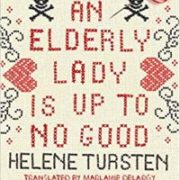Our Team: the Epic Story of Four Men and the World Series that Changed Baseball by Luke Epplin
When thinking of historic moments or teams in Major League Baseball, the 1948 Cleveland Indians did not leap to mind. That changed when I read Luke Epplin’s new book, Our Team: the Epic Story of Four Men and the World Series that Changed Baseball.
A very good friend recommended that I read “Our Team”. He said I would like it and, as is often the case, he was right. It is in turns biography, social history, sports history, and a recap of the crucial games in Cleveland’s 1948 season and World Series win.
Epplin focuses on four people: owner Bill Veeck, fielder Larry Doby, and pitchers Bob Feller and Satchel Paige. He introduces each man while telling us about the time in which they were living. If you didn’t already know, you’ll find out how very different it was to play baseball professionally if you were Black.
Bob Feller was a pitching phenom. His dad recognized and nurtured his talent. From his home field to high school and semi-professional baseball, crowds showed up to watch Feller pitch. He drew the attention of the Cleveland Indians and was signed to a contract in 1935, his junior year in high school.
Originally set to start in the minor leagues he pitched against the Cardinals in an exhibition game and skipped straight to the majors. Feller worked 3 innings and struck out 8 batters – sending him to the minors didn’t make sense.
In contrast Satchel Paige’s path to the Majors was long and arduous. He didn’t have a father to nurture his talent. He worked from a young age and actually learned to pitch at the Alabama Reform School for Juvenile Negro Lawbreakers. When he was released at 17 he signed with a Black semi-professional team to study the game and hone his talents.
He soon learned that people would pay to watch him pitch. Like Feller he was a phenomenal pitcher but Paige was also a showman. He was good at gauging the crowd and keeping them entertained. He played in the Negro League during the season and then, as many League players did, went south to keep playing to make a living.
To earn some extra money Major Leaguers also played after the season was over. Barnstorming games often pitted Negro Leaguers against Major Leaguers. In October 1936 Paige and Feller met for the first of many games they would pitch against each other. Neither allowed a run with Feller striking out 8 and Paige 7.
Paige was such a dominant pitcher and had so much success against Major League players that League executives deemed a white player that could hit off Paige ready to play in the Majors. Despite this, he would not get his chance in the Major Leagues until the summer of 1948 when he was 42 years old.
Larry Doby was born in the south but his family moved north to find work. With his father was mostly absent and his mother working as a live-in domestic, he lived with his grandmother in Camden, NJ. He spent his free time playing stickball. Before high school his mother moved him to Paterson, NJ so he could attend an integrated school. A natural gifted athlete he was a 3 sport star and welcome to socialize with all his teammates.
Unlike Paige, Doby never aspired to play in the Major Leagues. He had his pick of sports but wanted to play Negro League baseball. He signed with the Newark Eagles and was an instant success. World War II interrupted his stint with the Eagles but after the war he resigned and continued to improve.
His talent drew the eye of both the Dodgers and the Indians with the Indians buying his contract from the Eagles in the summer of 1947. Unlike what the Dodgers did with Jackie Robinson, Doby did not go into the Minor League system. He went straight to the Majors.
The man who brought Feller, Paige and Doby together for that championship year was Bill Veeck. Bill loved baseball. His father was team president of the Chicago Cubs and Bill worked for the Cubs himself until he had the opportunity to buy the Milwaukee Brewers. In Milwaukee he perfected what he would eventually bring to the Indians. He roamed the crowds during the games talking to people, he gave away prizes, and had firework shows.
He wanted to win almost as badly as he wanted to fill the stands and make sure the fans had a good time. He also wanted to integrate baseball. He did it with personnel and eventually his Indians became the first American League team to sign a Black player.
There is so much more about each of these men that Epplin explores – how World War II affected each man, Feller’s quest to secure his financial future, Paige’s style and remarkable longevity, Veeck’s energy, and Doby’s ability to excel amid the isolation and injustices he endured integrating the game while living in a segregated society.
Then of course there is the season. The ups and downs in the race for the pennant against the Yankees and the Red Sox. The season came down to a one game playoff against the Sox to determine who would face the Boston Braves in the series. Even though we know the result, Epplin keeps you turning the pages to see what happens next.
Epplin did his research and brought to life these four remarkable men and the time in which they lived. It is both an entertaining and sobering book you don’t have to be a baseball fan to enjoy.











